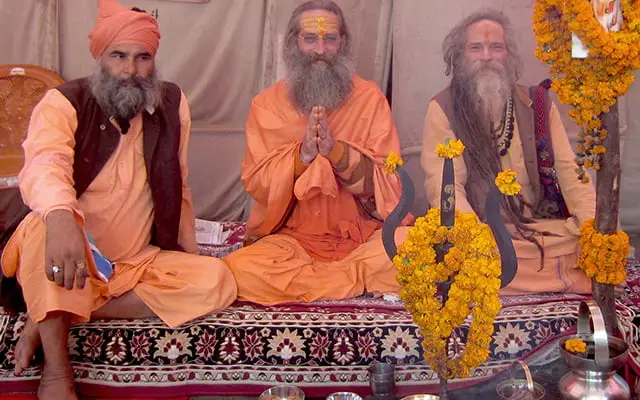
On the banks of India’s most sacred river, Ganga Ma …
the Kumbh Mela is humanity’s largest gathering
still celebrated after thousands of years as the greatest of Indian festivals.
[embedyt] http://www.youtube.com/watch?v=oy5zlucbyhg[/embedyt]
The Greatest of Indian Festivals – The Maha Kumbh Mela
Celebrated on the banks of India’s most sacred rivers, the Ganga, Kshipra, and Godavari, the Maha Kumbh Mela is the world’s oldest and largest spiritual gathering. Part mass pilgrimage and part festival, millions of people from all over the world – representing every culture, nationality and faith — come together every four years in India on this monumental and majestic occasion.
A Kumbh Mela presents a rare opportunity for the public to witness some of India’s oldest and most sacred rituals, passed down over many generations from the kings of India, performed by an elite of special Brahmin priests, and witnessed by monks, sages and sadhus – holy men and women from many different cultures around the world who only rarely appear in public on occasions of great significance such as the Mahakumbh.
The history of Kumbh Mela goes back to the time of the Rig Veda. Where the river Ganga and Yamuna join the invisible river Saraswati in a confluence known as the Sangam, great yajas, ancient rites and rituals have been performed for the prosperity and well being of the public, since time immemorial. That place is called Prayag Raj just outside of modern Allahabad. It is there where the Maha Kumbh Mela 2013 will be celebrated.
In India, often 60 million people will come to a Kumbh Mela festival to witness these traditional rites and rituals of invocation of the great personalities of Nature and the Sky, and to obtain the resulting blessings of peace and prosperity as well as those offered by the spiritual and religious leaders, plus sadhus and babas who have gathered for the event.
Kumbh Mela 2013 Schedule
[columns][one-half]
Juna Akhara
11th Nov. 2012 • Entry into Allahabad 11.15 AM
28th Nov. 2012 • Airth Puja 12 noon
06th Dec. 2012 • Dharma Flag Puja 11:15 AM
18th Dec. 2012 • Entry into Akhara Camp 1:55 PM
14th Jan. 2013 • Makar Sankranti Shahi Snan 6:05 AM
10th Feb. 2013 • Mauni Amavasya Shahi Snan 5:30 AM
15th Feb. 2013 • Basant Panchami Shahi Snan 7:10 AM[/one-half]
[one-half]
Date of other Maha Kumbh Mela 2013 Snans
27th of January • Paus Purnima Snan
06th of February • Ekadasi Snan (Bairagi)
17th of February • Rath Saptami Snan
18th of February • Bhishma Ekadashi Snan
25th of February • Maghi Purnima Snan [/one-half][/columns]

